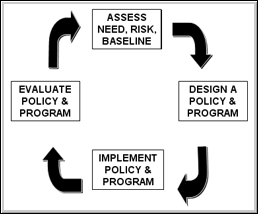| Module 6: Substance Abuse - Five Components Of Substance Abuse Programmes For The Workplace |
FIVE COMPONENTS OF SUBSTANCE ABUSE PROGRAMMES FOR THE WORKPLACE:
- Written substance abuse policy.
- Supervisor training.
- Employee education.
- Rehabilitation of employees.
- Substance abuse testing programme.
All the above, with the possible exclusion of a testing programme, need to be in place for a workplace substance abuse programme to be effective. Implementing employee education on its own for example, is unlikely to produce any substantial positive outcomes and is generally a waste of time and resources. It also runs the risk of during harm.
Substance abuse programmes should provide for the following:
- support for those who seek help and fair consequences for those who do not;
- early prevention and identification of potential problems and appropriate action;
- effective and efficient management of help-seeking and disciplinary processes;
- reduce substance abuse and related harm and costs.
Providing support for those who seek help, and providing consequences for those who do not, is the central tenant for all effective substance abuse programmes. It should also be taken to heart on a personal level by work colleagues and those in management or supervisory positions. Trying to hide a colleagues mistakes/absenteeism that are a result of substance abuse for example, is not helping the drug abuser. It allows the drug abuser to continue their drug use while avoiding any consequences and thereby removing incentives to seek help.
Advantages of a written substance abuse policy:
Among other things a written substance abuse policy encourages help seeking behaviour. It is important for staff members to know what to expect from their employer if they seek help for a substance abuse problem, or what the consequences will be if they bring a colleagues substance abuse problem to the attention of their employer.
A written policy:
- brings focus;
- helps communication;
- provides supportive guidelines;
- outlines the assistance the employee will provide to a staff member who has a substance abuse problem;
- outlines what steps will be required from the substance abuser e.g. to join an out-patient rehabilitation clinic;
- outlines the consequences for the substance abuser if they deviate from the agreed course of action; (sets limits with clear and fair consequences);
- provides for early intervention and prevention;
- allows for all-round protection;
- enables legal review;
- results in record keeping for reference purposes or evidence;
- allows for outside support.
Components of successful policies:
- a rationale - the reasons for why a policy is necessary;
- clear definitions - of terms such as "mood altering substance".
Note: It is important to include both legal (e.g. alcohol or prescription medications) and illegal substances.
- effective prevention strategies;
- procedures for:
- supporting genuine help-seeking;
- managing incidents (including policy violations);
- prevention & health promotion;
- benefits and assurances;
- flexibility to deal differently with each incident, even if the actual offense is the same.
Situations where a written policy can help:
- displaying signs of drug use;
- under the influence or in withdrawal;
- unconscious;
- incidences of self-disclosure or help-seeking behaviour;
- third-person disclosure;
- possession of substance;
- discovery of substance;
- treatment and recovery;
- testing;
- health promotion.
What needs to happen?:

In short, the process of rising to the challenge of substance abuse in the workplace, should begin with assessing the need for a substance abuse programme, the potential risks of not having such a programme, and accumulating baseline data on the potential costs of substance abuse in a particular workplace (productivity, absenteeism, on-site accidents etc). This data can be used to ascertain the effectiveness of a programme if one is implemented. The risks and costs relating to substance abuse will vary according to factors such as the size of the staff, the particular industry and geographic location. The next objective is to design a drug and alcohol policy and programme for the particular workplace, and implement it. A process of evaluation will reveal shortcomings of the policy, and also the benefits for the workplace e.g. increased staff morale, reduced absenteeism and reduced on-site accidents. This entire process will need to be reviewed periodically.
Urine Testing:
There is much debate regarding whether or not substance abuse testing programmes should be implemented in workplaces. There are pros and cons to implementing such a policy but it is generally accepted to be important for certain positions e.g. pilots or people in control of heavy machinery such as crane drivers.
In this regard one should bear in mind that:
- Not all drugs show up on test kits.
- A negative result does not indicate that a person is not using drugs, merely that they have not used certain drugs in the 3 days prior to the test, for example, ecstasy, cocaine, crack and heroin.
- Test kits are not accurate and can produce false positives.
- Addicts are extremely adept at adding masking agents to urine or using someone else’s urine in order to attain negative results.
| Drug Name |
Duration of Physical Effects |
Approximate Detection Time in Urine |
| Dagga |
2 - 4 hours |
Infrequent user: Up to 10 days
Chronic User: 30 days or longer |
| Mandrax |
4 - 8 hours |
Up to 2 weeks |
| Ecstasy |
8 hours |
2 - 4 days |
| LSD |
8 - 12 hours |
Up to 48 hours |
| Cocaine/Crack |
1 - 2 hours |
2 - 3 days |
| Benzodiazepines |
4 - 12 hours |
Up to 2 weeks |
| Amphetamine |
0.5 - 4 hours |
2 - 4 days |
| Opiates |
3 - 6 hours |
2 - 3 days |

